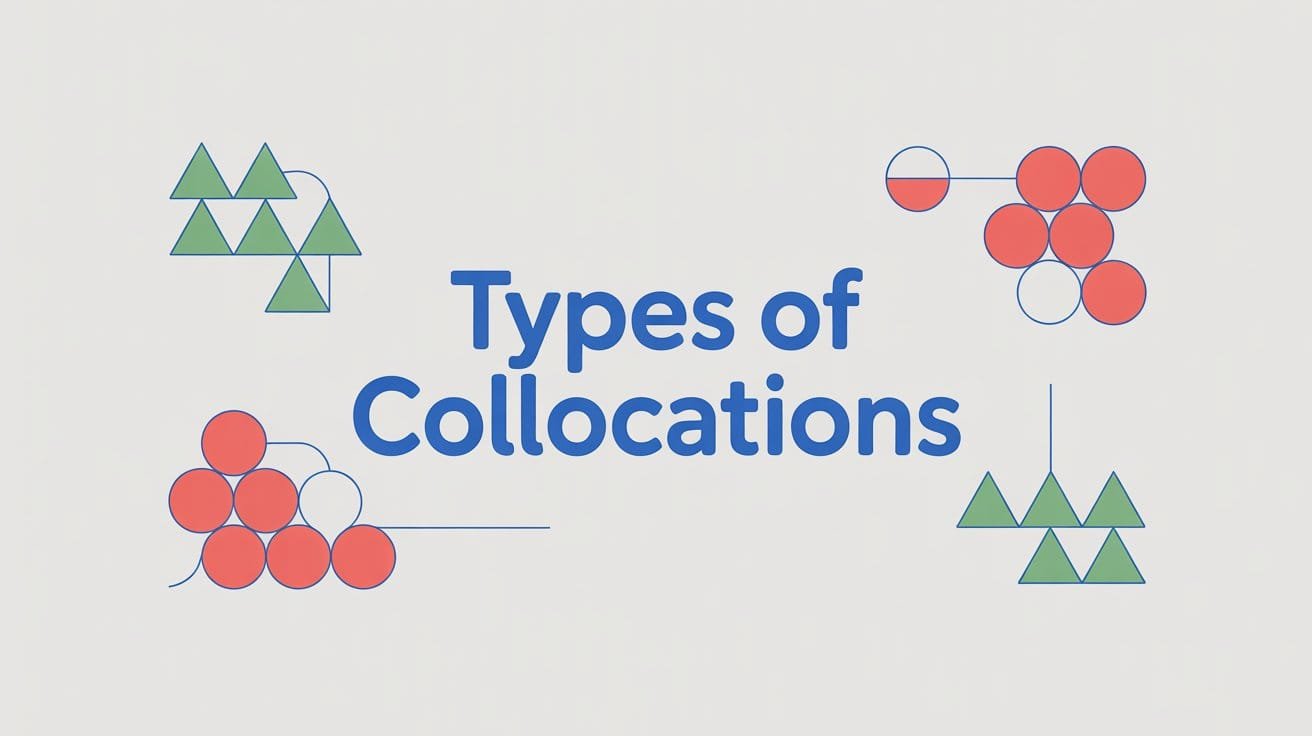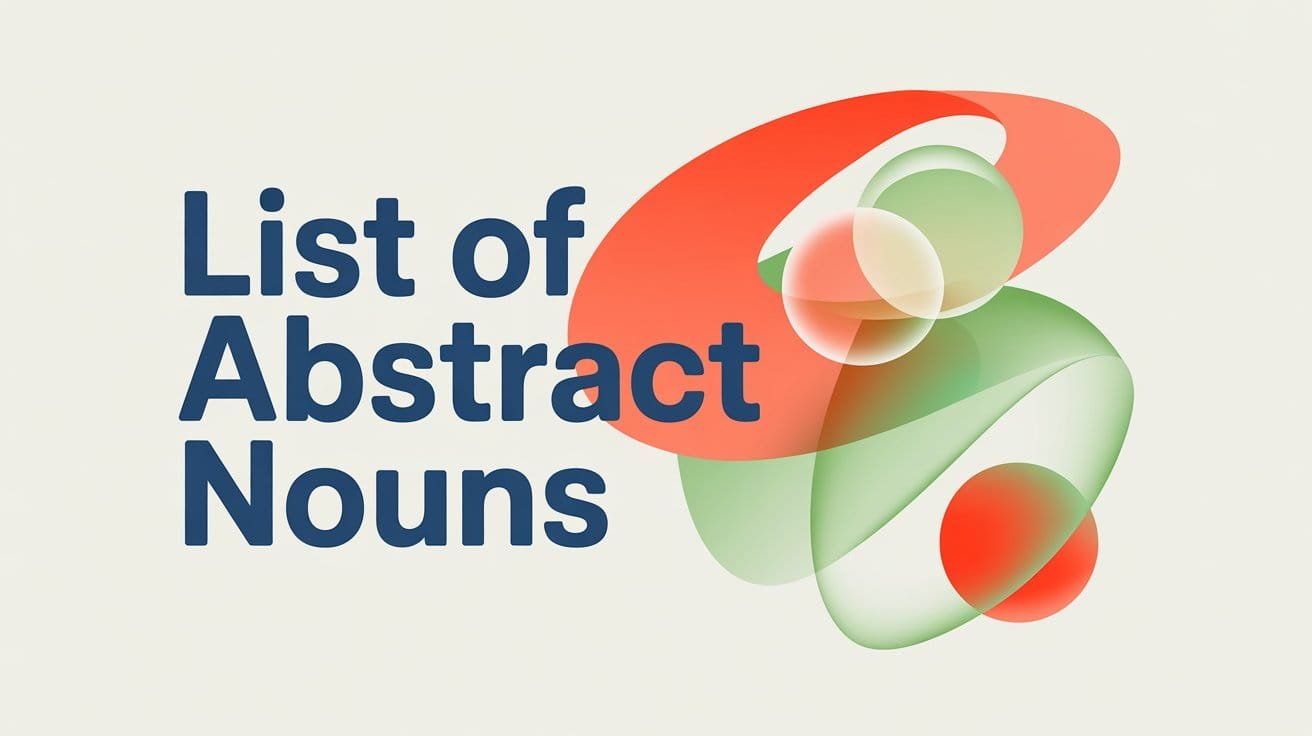In English, some words naturally belong together. We say make a choice and strong coffee because those combinations sound right to native speakers. These natural pairings are called collocations, and they play a major role in fluent communication.
However, not all collocations work the same way. Some are fixed expressions that rarely change, while others are flexible and allow slight variation. Understanding the types of collocations helps you know which combinations are most natural, which can be adapted, and how they fit into real communication.
This guide explains the main categories, lexical, grammatical, fixed, semi-fixed, flexible, strong, and weak collocations, with clear examples.
Lexical vs Grammatical Collocations
Collocations can be broadly divided into lexical and grammatical types. The difference lies in the kind of words that come together.
Lexical Collocations
Lexical collocations combine two or more content words—such as nouns, verbs, adjectives, or adverbs. These words carry meaning on their own and naturally form familiar combinations in English.
Examples:
- Verb + Noun: set goals, build trust, launch a campaign
- Adjective + Noun: bright idea, close friendship, heavy workload
- Adverb + Adjective: deeply committed, highly probable, perfectly clear
- Noun + Noun: job interview, language barrier, success rate
Lexical collocations are what most learners notice first. They make your English sound smooth and natural because they follow common patterns used by native speakers every day.
Grammatical Collocations
Grammatical collocations involve at least one function word—usually a preposition, infinitive, or clause structure. These combinations are essential for accuracy because changing one small word can make the expression incorrect.
Examples:
- Verb + Preposition: rely on, focus on, belong to
- Adjective + Preposition: interested in, responsible for, afraid of
- Noun + Preposition: increase in, solution to, reason for
- Verb + Infinitive / Gerund: agree to do, avoid doing, plan to go
Grammatical collocations are especially important in writing and exams, where precision matters. Learning them as fixed units—like depend on or participate in—helps you use them correctly without hesitation.
Fixed Collocations
A fixed collocation is a set phrase that cannot be changed without sounding incorrect or unnatural. The words always appear together in the same form and order.
Examples:
- by and large
- safe and sound
- as a matter of fact
- to and fro
- in short
These combinations behave almost like idioms—changing one word or the order breaks the expression. For instance, safe and sound is correct, but sound and safe is not commonly used.
Semi-Fixed Collocations
Semi-fixed collocations have a stable structure but allow small variations, such as using a different adjective, noun, or tense. The pattern stays the same, but one element can change.
Examples:
- make a (quick / strong / convincing) case
- take a (short / long) break
- keep an (open / close) eye on
- come to a (final / sudden / sensible) decision
These expressions are flexible within limits—you can swap one word while keeping the collocational pattern intact.
Flexible Collocations
Flexible collocations give more freedom in word choice. You can replace one part of the expression with another word that fits grammatically and contextually.
Examples:
- write / deliver / prepare a report
- offer / provide / give advice
- start / begin / continue a conversation
- build / maintain / strengthen relationships
Flexible collocations are useful in writing and speaking because they let you adapt your language without sounding unnatural. They help you vary your vocabulary while keeping a natural tone.
Strong vs Weak Collocations
Another way to classify collocations is by how tightly the words are connected. Some combinations are so common that only one word fits naturally, while others allow more flexibility. These are known as strong and weak collocations.
Strong Collocations
A strong collocation is a word pairing that occurs together almost exclusively. The two words are closely linked, and replacing one of them sounds unnatural to native speakers.
Examples:
- commit an offense
- harbor doubts
- bear responsibility
- draw conclusions
- express concern
These expressions sound natural only with their typical pairings. For instance, native speakers say express concern but rarely show concern in formal English. The more specific the pairing, the stronger the collocation.
Weak Collocations
Weak collocations are combinations where one word can easily be replaced by another without sounding wrong. They’re more flexible because the pairing isn’t unique or fixed.
Examples:
- big house / large house / huge house
- good idea / great idea / nice idea
- fast train / quick train / express train
- strong taste / distinct taste / rich taste
- heavy rain / intense rain / steady rain
While all of these examples are correct, the first version in each set is the one most commonly used by native speakers.
Types by Structure or Part of Speech
You can also understand collocations by looking at how words from different parts of speech naturally combine. Each structure has its own function in communication and appears frequently in both spoken and written English.
1. Verb + Noun Collocations
These combinations describe actions and their related objects. They’re common in everyday conversation and formal writing.
Examples:
- raise awareness
- hold a conversation
- deliver a speech
- set priorities
- draw attention
2. Adjective + Noun Collocations
An adjective often pairs with a particular noun to create a clear and natural description.
Examples:
- strong possibility
- growing concern
- bright future
- heavy workload
- mutual understanding
3. Noun + Noun Collocations
This structure often names a single idea or concept. You’ll see it frequently in business, science, and academic English. Many of these are fixed combinations that rarely change.
Examples:
- production cost
- climate change
- company policy
- traffic congestion
- energy source
4. Adverb + Adjective Collocations
Adverbs can intensify or modify adjectives, shaping the tone or strength of a description. These are common in writing that expresses opinion or evaluation.
Examples:
- deeply moved
- highly efficient
- perfectly acceptable
- widely recognized
- completely different
5. Verb + Preposition Collocations
Some verbs require a specific preposition to make sense. These are crucial for accuracy in grammar and meaning. Changing the preposition usually changes or distorts the meaning, so it’s best to learn these as complete units.
Examples:
- insist on
- apologize for
- depend on
- refer to
- believe in
6. Adjective + Preposition Collocations
Adjectives also pair with specific prepositions to express attitude, emotion, or relation.
Examples:
- familiar with
- capable of
- interested in
- satisfied with
- responsible for
7. Adverb + Verb Collocations
Adverbs modify verbs to describe how or to what extent an action is performed. These combinations sound natural and help express the speaker’s tone or attitude clearly.
Examples:
- firmly believe
- completely agree
- barely notice
- quickly respond
- strongly oppose
Mixed or Complex Collocations
Not all collocations are made of just two words. In English, many common expressions contain three or more words that regularly appear together. These are known as mixed or complex collocations. They often link verbs, nouns, and prepositions in fixed combinations that carry a single, natural meaning.
Multi-Word Collocations
These include expressions where a verb, object, and preposition form a stable phrase.
Examples:
- take advantage of
- keep in touch with
- give rise to
- come into effect
- put an end to
Each of these functions as one idea, even though it has several parts. For instance, take advantage of means “use a situation or opportunity,” not literally “take” something.
Extended Collocational Chains
Sometimes, collocations link together to form longer expressions that still sound natural.
Examples:
- pay close attention to detail
- play an important role in
- take full responsibility for
- make a significant contribution to
- have a positive impact on
These expressions are common in academic and professional English. They’re especially useful when writing essays, reports, or formal correspondence.
Collocations Within Fixed Phrases
Some fixed expressions include smaller collocations inside them.
Examples:
- as far as I know
- in the middle of nowhere
- at the end of the day
- from time to time
- in light of recent events
Each phrase has a clear collocational structure that feels natural to native speakers and appears frequently in real communication.
Tips for Using Types of Collocation Effectively
Understanding collocations is one thing; using them confidently is another. The following strategies will help you apply what you’ve learned about collocation types in everyday communication and writing.
Focus on High-Frequency Collocations First
Start with common expressions that native speakers use daily, such as make progress, take notes, or set goals. These lexical collocations appear often in reading, listening, and conversation, making them easier to learn through exposure.
Learn Collocations in Context
Whenever you find a new collocation, note the full sentence rather than just the pair of words.
For example, “The manager set clear expectations for the project.” This method helps you understand meaning, structure, and tone at the same time.
Group Collocations by Type
Organize new collocations according to their type—verb + noun, adjective + noun, or fixed expressions. You can also separate them by flexibility: fixed, semi-fixed, or flexible. This makes the review more systematic and helps you notice word patterns more easily.
Use Collocation Dictionaries and Tools
Reliable sources like the Oxford Collocations Dictionary or JustTheWord show authentic examples from real English. They help you check whether a combination sounds natural before you use it.
Example: Searching “solution” might show find a solution, provide a solution, or offer a solution—giving you options that all sound natural.
Practice Substitution
Take a common collocation and replace one part to see what variations are possible.
For instance: make a decision → make a plan → make an attempt
This technique strengthens your awareness of flexible collocations and shows you how to expand your vocabulary around familiar patterns.
Use Them in Your Own Writing and Speech
When writing essays, emails, or even short notes, consciously use collocations instead of single words.
For example, instead of I improved my English, try I made noticeable progress in English. The meaning stays the same, but the phrasing sounds smoother and more natural.
Frequently Asked Questions about Types of Collocations
What is a collocation?
A collocation is a natural combination of words that frequently appear together in English. These word pairings sound right to native speakers because of repeated use. Example: make a mistake, heavy rain, take responsibility.
What are the 7 types of collocation?
The main types of collocations are:
Verb + Noun (set goals)
Adjective + Noun (strong possibility)
Noun + Noun (company policy)
Adverb + Adjective (highly effective)
Verb + Preposition (depend on)
Adjective + Preposition (familiar with)
Adverb + Verb (firmly believe)
How do you identify a collocation?
You can identify a collocation by noticing which words often appear together in authentic English texts. If a phrase sounds natural and you’ve seen or heard it many times—like take a break or pay attention—it’s likely a collocation. Using collocation dictionaries or tools such as JustTheWord and SkELL also helps confirm common pairings.
What is the most common collocation?
There isn’t one single “most common” collocation, but some expressions appear across nearly all forms of English, such as make a decision, take notes, have breakfast, and do homework. These everyday pairings are recognized and used by native speakers everywhere.
Is there a rule for collocation?
There’s no fixed grammatical rule for collocations—they’re based on usage and frequency. Native speakers learn them naturally through exposure. The best way to learn is to observe which words consistently appear together and practice using them in your own sentences.
Is salt and pepper a collocation?
Yes, salt and pepper is a fixed collocation because the words always appear in that order. Switching them (pepper and salt) would sound odd, even though it’s grammatically correct. This kind of collocation is set by convention and common use.
What are some examples of strong collocation?
Strong collocations are pairs that almost always appear together and rarely change. Examples: commit a crime, express concern, bear responsibility, draw conclusions, harbor doubts. These expressions sound natural only in their usual combinations.



